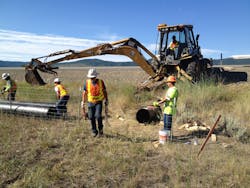HDPE pipe used to slipline and rehabilitate CMP culvert in Oregon
In Baker City, Ore., two corrugated metal pipe (CMP) culverts ran underneath a two-way road. Like many of these pipe systems across the country, these two CMP culverts were rusting and deteriorating at a rapid rate. Bradley Payton, Baker City’s transportation maintenance manager, was charged with working with the Oregon Department of Transportation (ODOT) to solve the problem before the culvert failed and the roadway above became unstable. “These culverts will eventually fail, which could lead to a build-up of water in the drainage area,” he said, explaining the threat.
When replacing culverts, the common choice is between digging up and replacing the pipe or finding a way to rehabilitate the existing pipe. Because the 39-in. CMP culverts were located under a crucial road, the main challenge was finding a way to repair the pipes without disrupting the traffic pattern on that road. Digging up and replacing those culverts would have been a massive inconvenience to the motoring public, not to mention extremely costly in both time and money.
NW Relining LLC, an Olympia, Wash.-based company, is a distributor for Snap-Tite products. Sales rep Grey Langemo worked with Payton to find a solution that would save time and money without the need to interrupt traffic. They decided to use 32-in. high-density polyethylene (HDPE) pipe to slipline and rehabilitate the existing CMP. The annular space is filled with grout to hold the liner in place. Though the diameter of the pipe is decreased, the hydraulic flow capacity is improved.
The Snap-Tite system will never rust or corrode. It is durable and long-lasting. The primary alternative to Snap-Tite—digging up and replacing the pipe—would require the city to close the road, disrupt the flow of traffic, and cost the city large amounts of money and time. Snap-Tite can be installed comparatively easily and inexpensively. The new Snap-Tite liner will not leak and will last for decades to come, far outlasting the pipe it rehabilitates.
A unique feature of Snap-Tite is that it does not require fusion to join the HDPE pipe together. The patented male/female machining at each end of the HDPE allows the pipe ends to be ‘snapped’ together, piece-by-piece, and pushed into the full length of the existing pipe.
This will not be the only culvert facing failure. Now, ODOT is prepared with a cost-effective, long-lasting solution. “We were completely satisfied with the entire process and end result of the project, and will continue to use Snap-Tite for upcoming projects,” added Payton. Baker City now has a reliable source to prevent culvert failure in the future and to keep their roads in safe operating condition.
